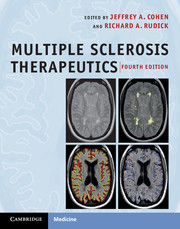
-
Select format
-
- Publisher:
- Cambridge University Press
- Publication date:
- 05 December 2011
- 20 October 2011
- ISBN:
- 9781139023986
- 9780521766272
- Dimensions:
- (276 x 219 mm)
- Weight & Pages:
- 2.4kg, 770 Pages
- Dimensions:
- Weight & Pages:
- Subjects:
- Neurology and Clinical Neuroscience, Medicine
You may already have access via personal or institutional login- Subjects:
- Neurology and Clinical Neuroscience, Medicine
Book description
This book comprehensively reviews the current state of clinical trial methods in multiple sclerosis treatment, providing investigators, sponsors and specialists with current knowledge of outcome measures and study designs for disease and symptom management. The status of the rapidly evolving field of disease-modifying drugs is presented, with emphasis on the most promising therapies currently being tested. Experts discuss disease and symptom management for MS subtypes, including neuromyelitis optica and pediatric MS. In addition, key scientific advances in MS pathology, genetics, immunology and epidemiology are presented. The fourth edition has been extensively revised, featuring more than 50% new material. All chapters have been substantially updated to provide current information on rapidly evolving topics and this volume contains 15 new chapters, reflecting the growth of the field in recent years. This book is an essential reference for practitioners caring for MS patients, investigators planning or conducting clinical trials, and clinical trial sponsors.
Contents
Metrics
Full text views
Full text views help Loading metrics...
Loading metrics...
* Views captured on Cambridge Core between #date#. This data will be updated every 24 hours.
Usage data cannot currently be displayed.
Accessibility standard: Unknown
Why this information is here
This section outlines the accessibility features of this content - including support for screen readers, full keyboard navigation and high-contrast display options. This may not be relevant for you.
Accessibility Information
Accessibility compliance for the PDF of this book is currently unknown and may be updated in the future.


